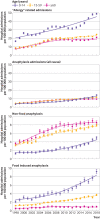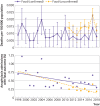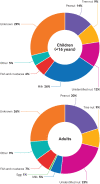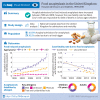Food anaphylaxis in the United Kingdom: analysis of national data, 1998-2018
- PMID: 33597169
- PMCID: PMC7885259
- DOI: 10.1136/bmj.n251
Food anaphylaxis in the United Kingdom: analysis of national data, 1998-2018
Erratum in
-
Food anaphylaxis in the United Kingdom: analysis of national data, 1998-2018.BMJ. 2021 Mar 19;372:n733. doi: 10.1136/bmj.n733. BMJ. 2021. PMID: 33741551 Free PMC article. No abstract available.
Abstract
Objective: To describe time trends for hospital admissions due to food anaphylaxis in the United Kingdom over the past 20 years.
Design: Analysis of national data, 1998-2018.
Setting: Data relating to hospital admissions for anaphylaxis and deaths, and prescription data for adrenaline autoinjector devices.
Participants: UK population as a whole and devolved nations (England, Scotland, Wales, and Northern Ireland).
Main outcome measures: Time trends, age, and sex distributions for hospital admissions for anaphylaxis due to food and non-food triggers, and how these admission rates compare with the case fatality rate (number of fatalities as a proportion of hospital admissions).
Results: Between 1998 and 2018, 101 891 people were admitted to hospital for anaphylaxis. Of these admissions, 30 700 (30.1%) were coded as due to a food trigger. Food anaphylaxis admissions increased from 1.23 to 4.04 per 100 000 population per year (from 1998 to 2018), an annual increase of 5.7% (95% confidence interval 5.5% to 5.9%, P<0.001). The largest increase in hospital admissions was observed in children younger than 15 years, with an increase from 2.1 to 9.2 admissions per 100 000 population per year (an annual increase of 6.6%, 95% confidence interval 6.3% to 7.0%). For comparison, the annual increase was 5.9% (5.6% to 6.2%) in people aged 15-59 years and 2.1% (1.8% to 3.1%) in those aged 60 years and older. 152 deaths were identified where the fatal event was probably caused by food induced anaphylaxis. The case fatality rate decreased from 0.7% to 0.19% for confirmed fatal food anaphylaxis (rate ratio 0.931, 95% confidence interval 0.904 to 0.959, P<0.001) and to 0.30% for suspected fatal food anaphylaxis (0.970, 0.945 to 0.996, P=0.024). At least 46% (86 of 187, which also includes 35 deaths in 1992-98) of deaths were triggered by peanut or tree nut. Cow's milk was responsible for 17 of 66 (26%) deaths in school aged children. Over the same time period, prescriptions for adrenaline autoinjectors increased by 336% (estimated rate ratio 1.113, 95% confidence interval 1.112 to 1.113; an increase of 11% per year).
Conclusions: Hospital admissions for food induced anaphylaxis have increased from 1998 to 2018, however the case fatality rate has decreased. In school aged children, cow's milk is now the most common single cause of fatal anaphylaxis.
© Author(s) (or their employer(s)) 2019. Re-use permitted under CC BY. No commercial re-use. See rights and permissions. Published by BMJ.
Conflict of interest statement
Competing interests: All authors have completed the ICMJE uniform disclosure form at www.icmje.org/coi_disclosure.pdf and declare grants from UK Medical Research Council and UK Food Standards Agency for the submitted work; PJT reports grants from JM Charitable Foundation, NIHR/Imperial Biomedical Research Centre and End Allergies Together, outside the submitted work; personal fees from UK Food Standards Agency, DBV Technologies, Aimmune Therapeutics, Allergenis and ILSI Europe outside the submitted work; RJB reports personal fees from Prota Therapeutics, DBV Technologies, Cochrane Collaboration, John Wiley and Sons on behalf of Clinical and Experimental Allergy, personal fees from giving expert testimony, outside the submitted work; the other authors do not report any conflicts of interest.
Figures









Comment in
-
Fatal anaphylaxis: making sure all cases are counted.BMJ. 2021 Mar 15;372:n691. doi: 10.1136/bmj.n691. BMJ. 2021. PMID: 33722848 No abstract available.
References
-
- BBC. Severe allergic reactions rise in children in England over past five years. https://www.bbc.co.uk/news/health-50423095.
-
- National Institute for Health and Care Excellence. Anaphylaxis: assessment to confirm an anaphylactic episode and the decision to refer after emergency treatment for a suspected anaphylactic episode. 2011. http://www.nice.org.uk/guidance/CG134 - PubMed
Publication types
MeSH terms
Substances
Grants and funding
LinkOut - more resources
Full Text Sources
Other Literature Sources
Medical
Miscellaneous
